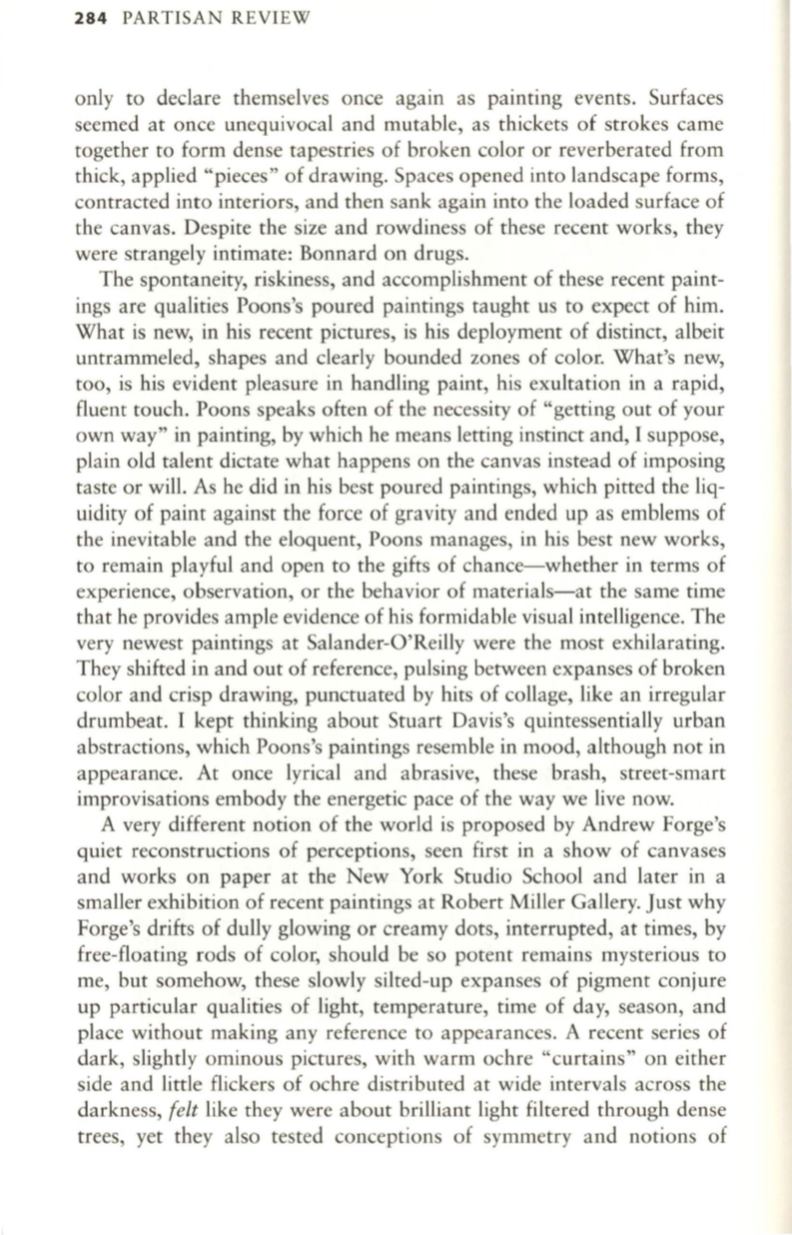
284
PARTISAN REVIEW
only to declare themselves once again as pamtmg events. Surfaces
seemed at once unequivocal and mutable, as thickets of strokes came
together to form dense tapestries of broken color or reverberated from
thick, applied "pieces" of drawing. Spaces opened into landscape forms,
contracted into interiors, and then sank again into the loaded surface of
the canvas. Despite the size and rowdiness of these recent works, they
were strangely intimate: Bonnard on drugs.
The spontaneity, riskiness, and accomplishment of these recent paint–
ings are qualities Poons's poured paintings taught us to expect of him.
What is new, in his recent pictures, is his deployment of distinct, albeit
untrammeled, shapes and clearly bounded zones of color. What's new,
too, is his evident pleasure in handling paint, his exultation in a rapid,
fluent touch. Poons speaks often of the necessity of "getting out of your
own way" in painting, by which he means letting instinct and, I suppose,
plain old talent dictate what happens on the canvas instead of imposing
taste or will. As he did in his best poured paintings, which pitted the liq–
uidity of paint against the force of gravity and ended up as emblems of
the inevitable and the eloquent, Poons manages, in his best new works,
to remain playful and open to the gifts of chance-whether in terms of
experience, observation, or the behavior of materials-at the same time
that he provides ample evidence of his formidable visual intelligence. The
very newest paintings at Salander-O'Reilly were the most exhilarating.
They shifted in and out of reference, pulsing between expanses of broken
color and crisp drawing, punctuated by hits of collage, like an irregular
drumbeat. I kept thinking about Stuart Davis's quintessentially urban
abstractions, which Poons's paintings resemble in mood, although not in
appearance. At once lyrical and abrasive, these brash, street-smart
improvisations embody the energetic pace of the way we live now.
A very different notion of the world is proposed by Andrew Forge's
quiet reconstructions of perceptions, seen first in a show of canvases
and works on paper at the New York Studio School and later in a
smaller exhibition of recent paintings at Robert Miller Gallery. Just why
Forge's drifts of dully glowing or creamy dots, interrupted, at times, by
free-floating rods of color, should be so potent remains mysterious to
me, but somehow, these slowly silted-up expanses of pigment conjure
up particular qualities of light, temperature, time of day, season, and
place without making any reference to appearances. A recent series of
dark, slightly ominous pictures, with warm ochre "curtains" on either
side and little flickers of ochre distributed at wide intervals across the
darkness,
felt
like they were about brilliant light filtered through dense
trees, yet they also tested conceptions of symmetry and notions of


